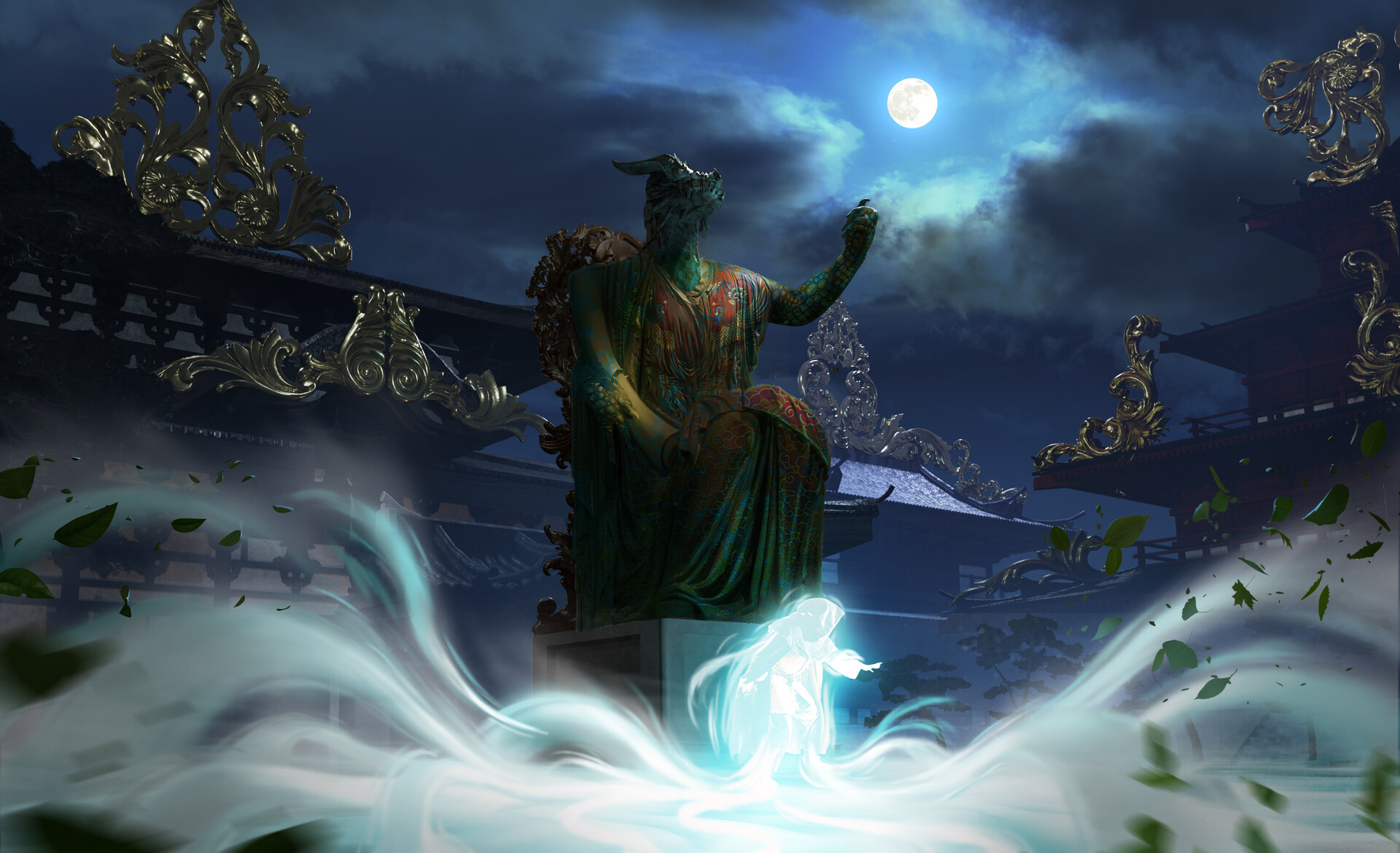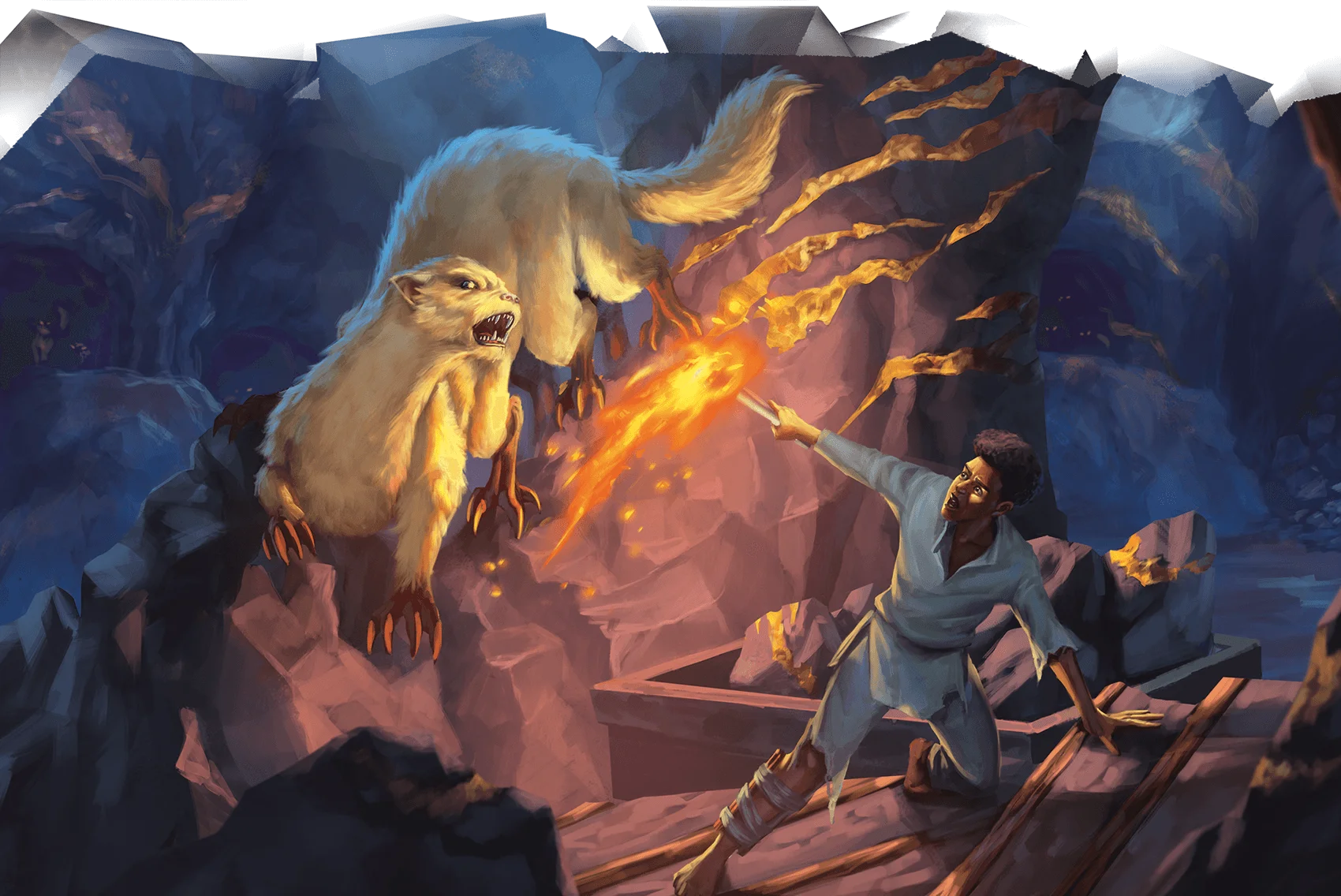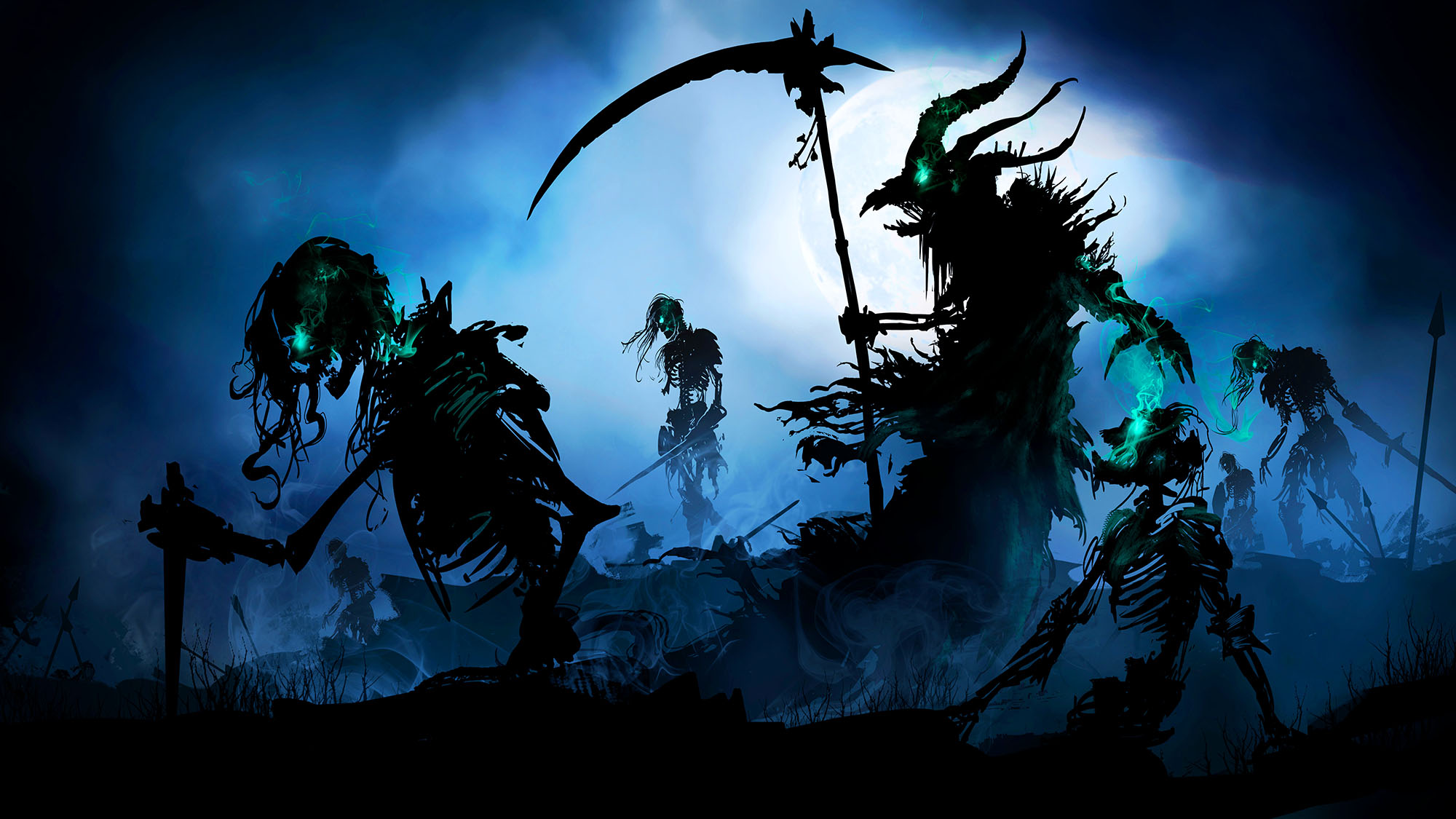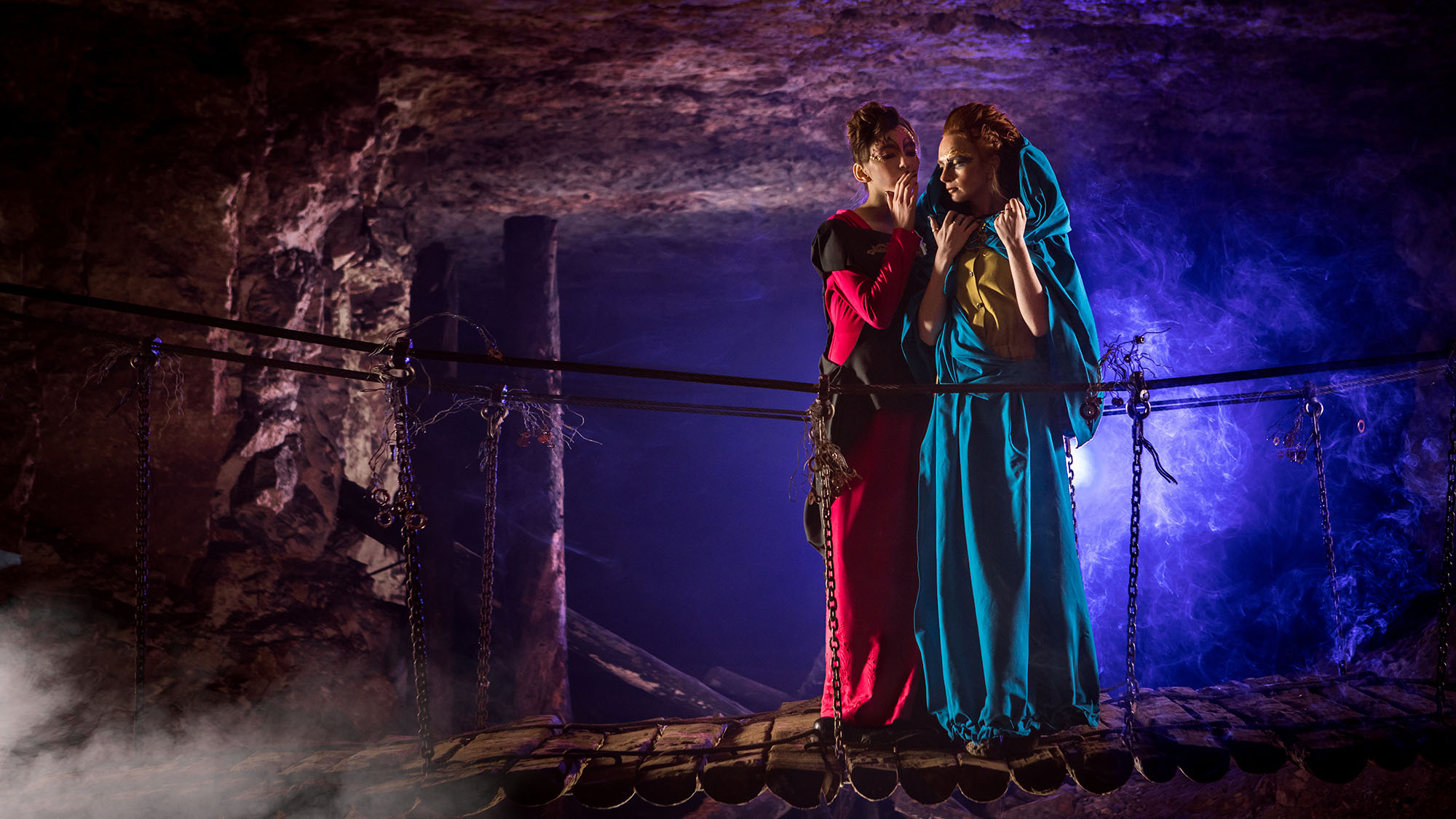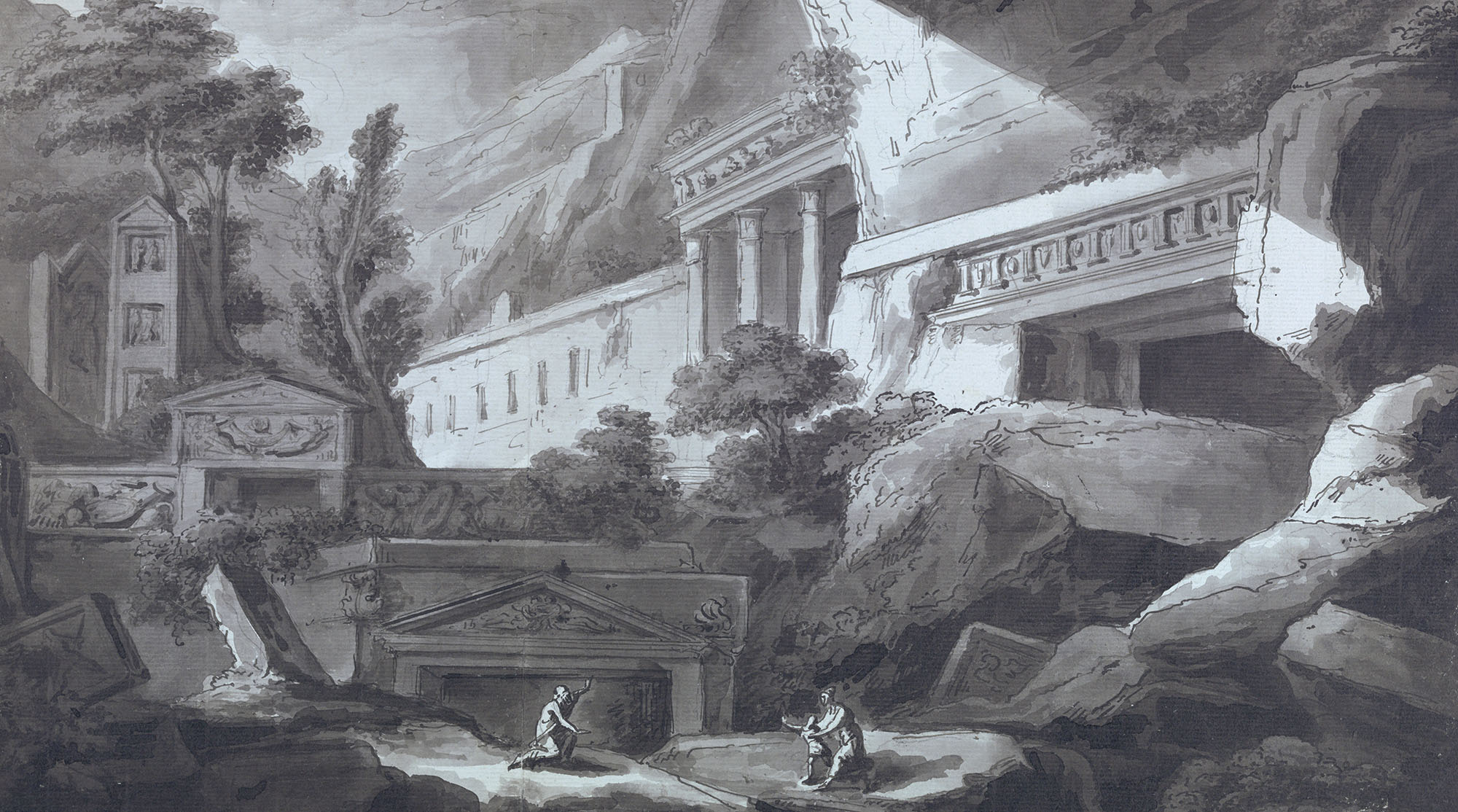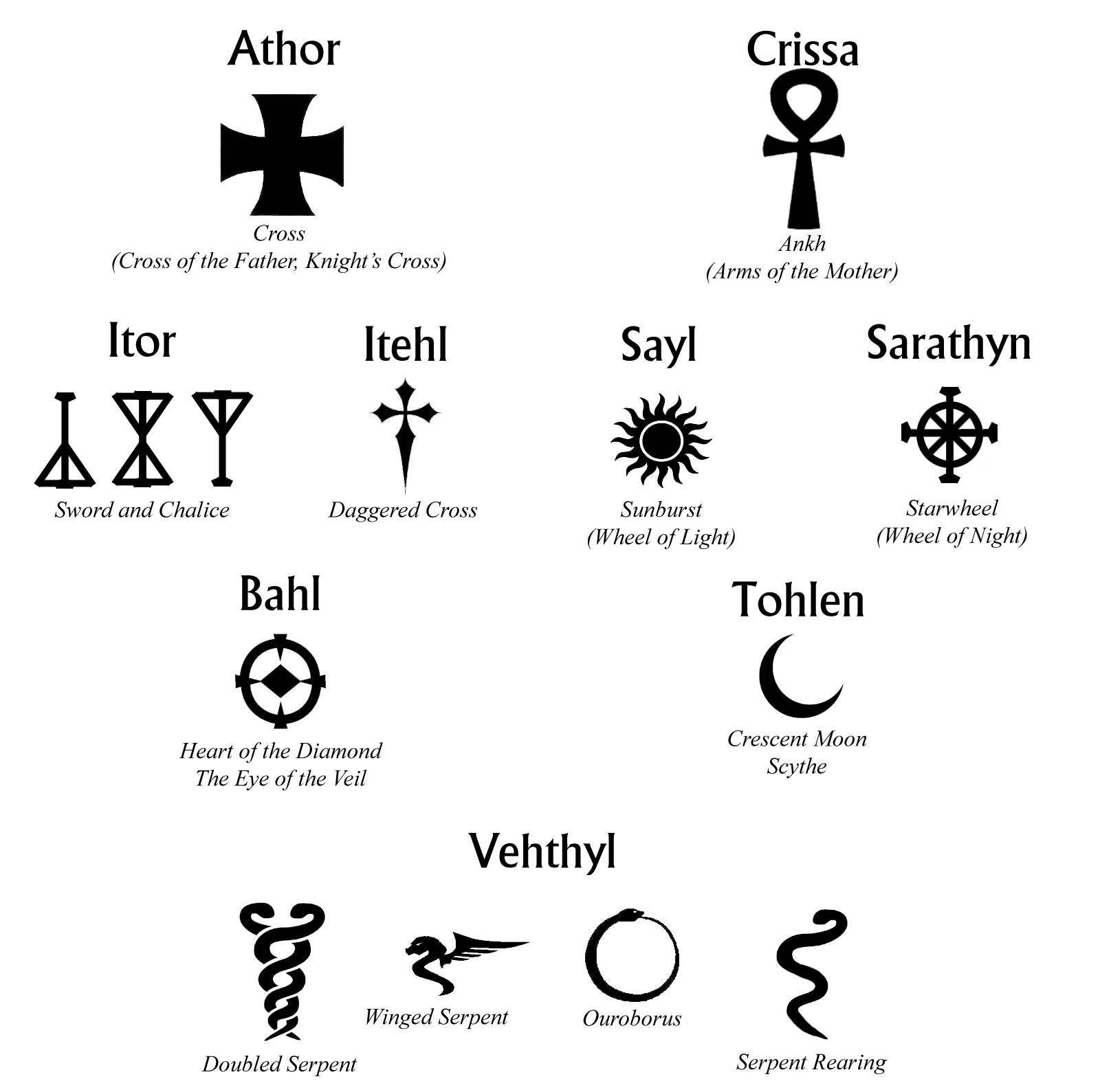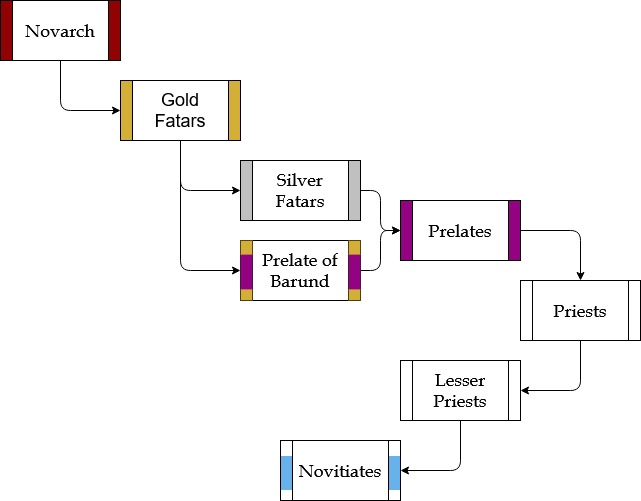WAGES OF VICE (T.K. Johnson) struggles quite a bit with continuity problems and fragility, with the former also contributing quite a bit to the latter.
There are two major continuity glitches. First, it’s fairly clear that the original premise of the adventure was changed at the eleventh hour. As published, the premise of the adventure is that five years ago the Kings of Coin — who rule the city-state of Zinda — made a deal with a witch named Proud Edun. The witch would use her magic to create the jeli flower, a crop with fantastic commercial value which would make Zinda (and, more importantly, the Kings of Coin) fabulously rich.
In return, the Kings of Coin agreed that their firstborn children would all serve as Proud Edun’s apprentices, learning her magical arts. But Myx Nargis Ruba, one of the Kings of Coin, said, “Hey. What if, instead of doing that, we just murder her?”
And the other Kings of Coin agreed and Proud Edun was murdered.
But there’s enough references scattered around the adventure, that it’s clear the original version of this backstory was that Proud Edun was promised the souls of the children. (If I had to make a wild guess, I would guess this was changed because it was too similar to the premise for “The Fiend of Hollow Mine.”) The problems this creates, however, are mostly ignorable.
The other major continuity glitch, though, is more fundamental. The premise of the adventure is that Proud Edun’s daughter, Kala Mabarin, has shown up to claim revenge by killing the kids who were supposed to be apprenticed to her mother. After the first murder, though, reality in the adventure just kind of bifurcates.
In one half of the adventure, Madame Samira Arah — the newest member of the Kings of Coin who (a) doesn’t know about the original double-cross of Proud Edun and (b) is the commanding officer of the Silent Verse, which is the Kings of Coin’s police force — has warned the Kings of Coin of the danger posed by Kala Mabarin and ordered all of their kids into protective custody.
In the other half of the adventure, however, nobody has warned the Kings of Coin and their kids are just wandering around, attending official functions, and getting openly targeted by Kala Mabarin.
This state of affairs just kind of randomly switches back and forth, depending on whichever scene the PCs happen to be in at the moment. It’s incredibly disorienting and fairly fundamental to the scenario, making it one of those crux points where I find players start checking out because the game world stops feeling real to them.
This is compounded because the core structure of the scenario is simultaneously arbitrary, unintuitive, and deprotagonizing.
The basic hook is that the PCs arrive in Zinda to attend — and I know this is going to shock you — a festival. As soon as they arrive at the festival, which is called the March of Vice, they stumble upon the corpse of Jacopo, Kala’s second target and first victim. They get sucked up into the investigation when Madame Samira arrives on the scene and says, “Outsiders? Sounds useful for a case that reeks of powerful conspiracies.”
I love Madame Samira. She’s a fantastic character. I think she’s the major saving grace of the entire adventure. She is simultaneously outsider and insider, and the more she learns about what 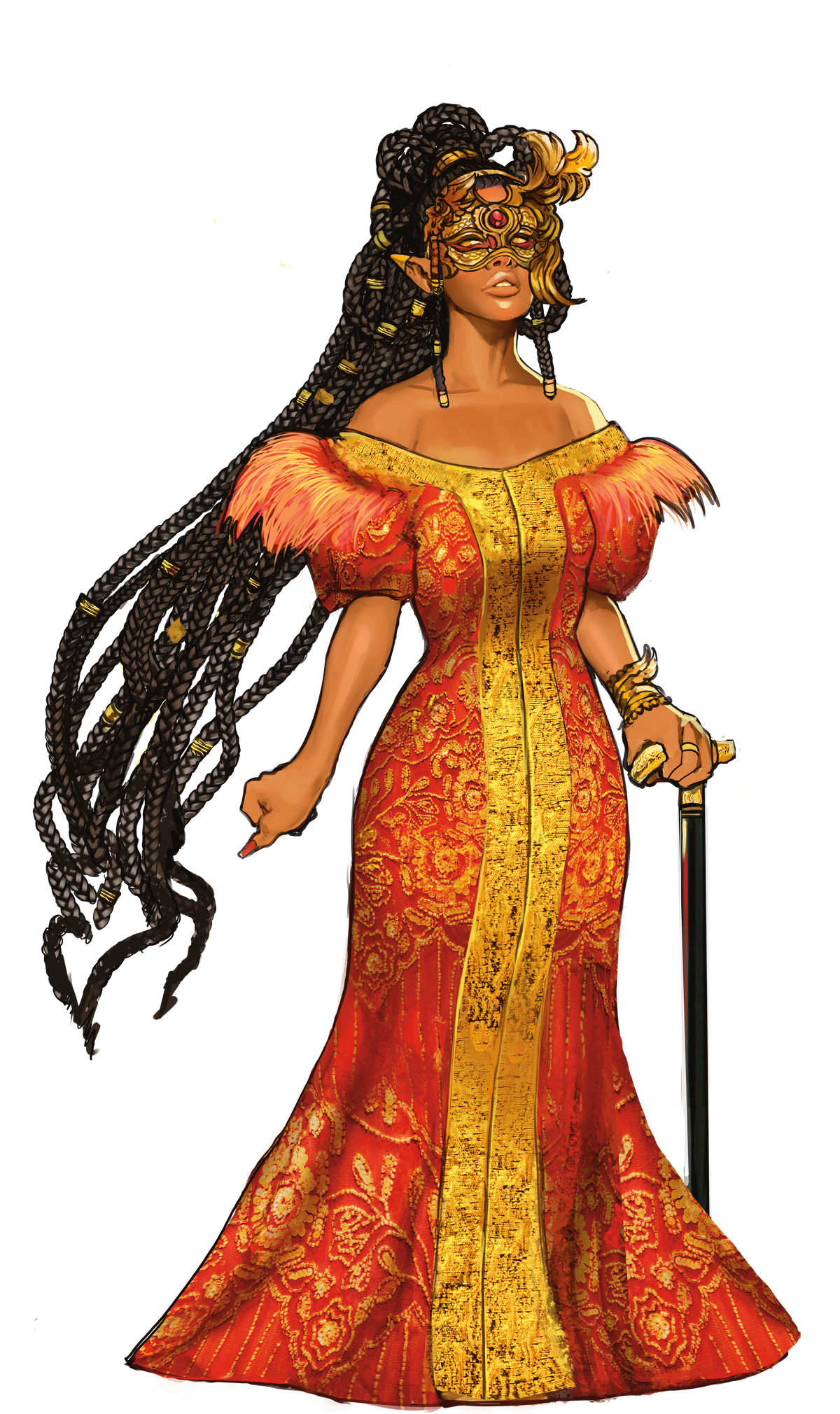 really happened, the more she’s like, “Blackmail over all my political rivals? How fascinating. Tell me more.”
really happened, the more she’s like, “Blackmail over all my political rivals? How fascinating. Tell me more.”
Samira’s own conflict between what’s right and what’s useful adds a delightfully independent vector of ethical haze to a scenario that’s already dripping with moral gray.
From this point, the “investigation” (which can only be loosely described as such) follows a linear path:
- Samira hires the PCs and tells them to go to Thornapple tavern, where they can question Zenia, one of the Coin heirs. Zenia was targeted for assassination yesterday, but escaped, triggering the lockdown.
- On the way to the Thornapple, the PCs coincidentally walk straight into another assassination attempt.
- At the Thornapple, the PCs walk straight into another assassination attempt. (A redo on Zenia.)
- Zenia’s father then confesses that this is all his fault and tells the PCs the whole back story with Proud Edun…
… and this is weird, because he doesn’t actually know that. He has no information identifying the killer as Kala or linking Kala to Proud Edun. (That doesn’t happen until later in the scene and only if (a) the PCs took prisoners and (b) they succeed on a skill check.)
In any case…
- The PCs have absolutely no leads. However, if they’ve learned what Kala looks like (which they easily may not), they can just ask around randomly to see if anyone on the street has seen her. If they do, a random person will tell them, “Yes. She was heading towards the conclusion of the adventure.”
- The PCs can then head to the conclusion of the adventure and walk straight into another assassination attempt, where they can either capture, kill, or negotiate with Kala.
Ultimately, “Wages of Vice” is juggling some really interesting ideas, but doesn’t really manage to pull it off, in my opinion.
Grade: D
Prep Notes: If you’re running this adventure, I recommend prepping a list of the Kings of Coin and their kids. “Okay, so who are the kids being threatened?” is a question the players are very likely to ask. The adventure has this information, but it’s scattered across the text in a very unuseful way.
SINS OF OUR ELDERS (Stephanie Yoon) sees the PCs leave the wine festival in Zinda so that they can head over to the springtime festival of Dan-Nal in Yeonido.
The core cool of Yeonido are the gwishin. Derived from Korean mythology, the dead in Yeonido often rise as undead spirits with unfinished business. This often includes fulfilling unfulfilled duty or correcting imbalance or injustice.
I really love Yoon’s decision to make the gwishin a central pillar of Yeonido as a setting — a haunted city that seeks to draw a veil over their unquiet spirits while discretely making right what they can and appeasing what they cannot. You can frame up an entire campaign with this concept: ghost-hunters settling sins-made-manifest. Virtually any adventure you can imagine can be hung from gwishin hooks with a uniquely supernatural flair: one part Perry Mason, one part Cold Case, one part The Ring.
“Sins of Our Elders” is, of course, itself based around a gwishin mystery. Long ago, the magistrate Dae Won-Ha spent decades doing ??? that resulted in prosperity for Yeonido, but her work was constantly being undermined by Young-Gi, the younger brother of Queen Young-Soo. Young-Gi’s efforts failed, and Won-Ha became a hero of the common people, but also Young-Gi succeeded and Won-Ha became a figure of infamy. Also Young-Gi arranged it so that the credit for whatever it was Won-Ha had done was given to Queen Young-soo. This all happened so long ago that the infamous(?) Won-Ha has passed from living memory, and also so recently that Young-Gi and other people who knew her personally are still alive.
Ten years ago, Queen Young-Soo died and Won-Ha’s gwishin appeared. The PCs need to figure out who the gwishin is, why she’s pissed off, and how she can be appeased.
The core problems of “Sins of Our Elders” mostly have their root in this backstory. It’s vague at best and seemingly contradictory more often than not. The problem is that it’s incredibly difficult to 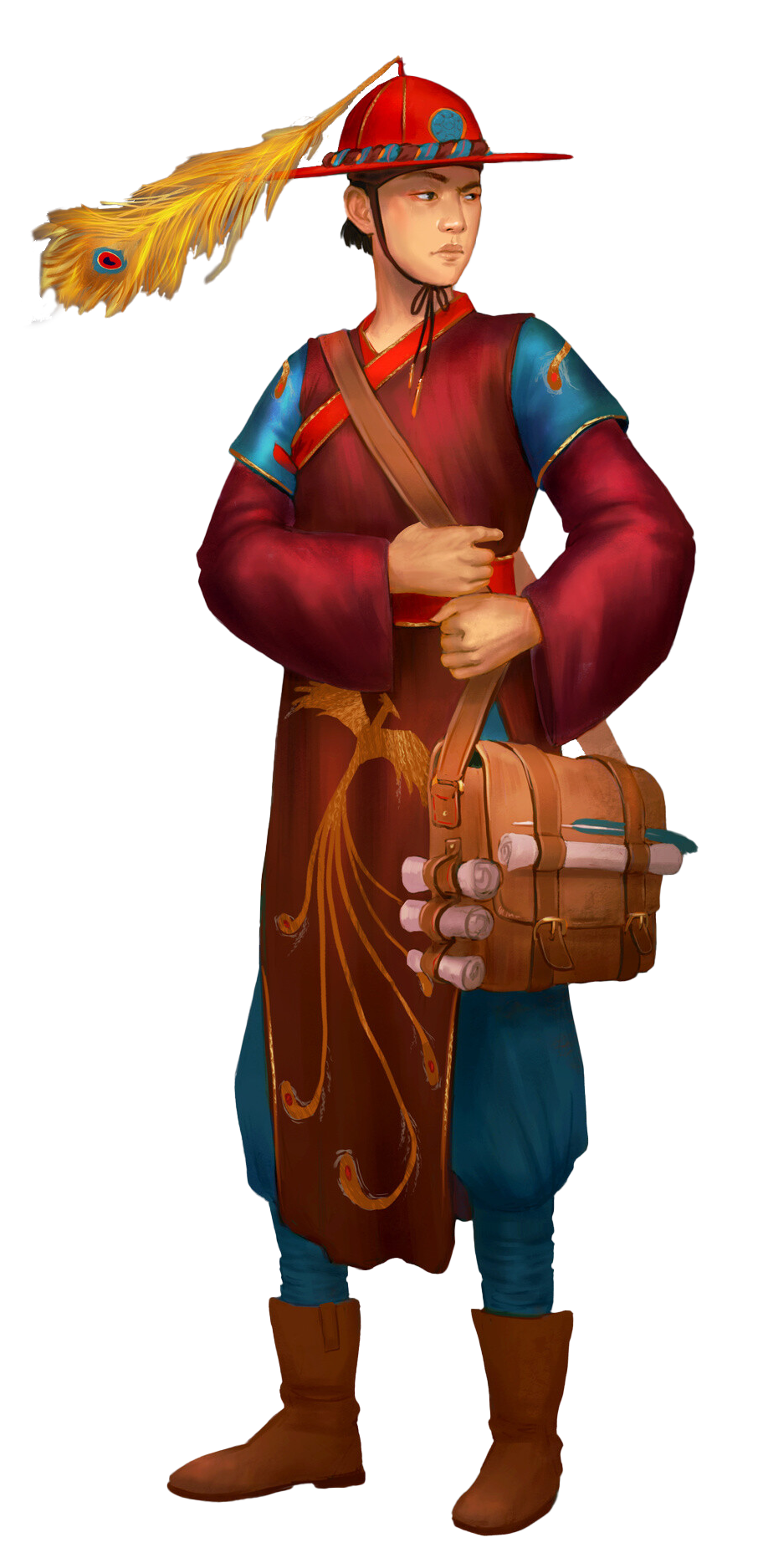 design a coherent mystery when the solution to the mystery hasn’t been defined. It’s like a murder mystery where the solution is “somebody was killed somewhere with some sort of weapon.” You can’t really build clues to reveal the truth if there’s no truth to be revealed, and so “Sins of Our Elders” continually struggles to provide clear clues for Won-Ha’s true legacy because “she did good stuff” doesn’t give you any sort of concrete revelation.
design a coherent mystery when the solution to the mystery hasn’t been defined. It’s like a murder mystery where the solution is “somebody was killed somewhere with some sort of weapon.” You can’t really build clues to reveal the truth if there’s no truth to be revealed, and so “Sins of Our Elders” continually struggles to provide clear clues for Won-Ha’s true legacy because “she did good stuff” doesn’t give you any sort of concrete revelation.
You can see another example of this vague backstory infecting the adventure in the hook. Dae Won-Ha has been taking her revenge on Yeonido in the form of a magical fog. The fog descends on an area, robbing the people there of their memory while Won-Ha wreaks havoc and destruction and terror. Then the people sort of “wake up” in the aftermath, ignorant of everything they did (and that happened in the fog).
This curse is beautifully thematic: The Yeonidons don’t even realize what’s happening to them. It’s a curse of forgetfulness as vengeance for being forgotten.
So, as I mentioned before, this has been going on for ten years when the PCs arrive in Yeonido. The fog doesn’t affect outsiders, so the PCs immediately realize that something weird is—
Hold up.
It’s been ten years and no outsiders have come to Yeonido and noticed the fog in all that time?
At the other end of the adventure, the conclusion is also fatally flawed by the lack of a clear foundation.
Logically, “Sins” is an adventure that would end with the PCs discovering the true story of Dae Won-Ha and then taking action to make sure the truth is known. But there isn’t a true story to discover, so there’s nothing for the PCs to reveal. This forces a conclusion which can be roughly summarized as, “Jeez, Won-Ha. You’re really overreacting. Yes, the Queen and her brother conspired to rewrite the history books and make you look like a villain, but we found a teacup you signed that was gathering dust on a shelf and a couple other trinkets, so it’s not like you’re completely forgotten.”
And then Won-Ha is like, “Yes. You’re right. As long as that teacup is gathering dust, I can rest easy in my grave.”
I really want to like “Sins of Our Elders” because there’s some really cool potential in it, but it just doesn’t quite hold together for me.
I would give the adventure itself a D, but the raw potential of the Yeonido setting gazetteer pulls the whole package up into the C-range.
Grade: C-
Prep Notes: What “Sins of Our Elders” desperately craves is a specificity. A specific truth that happened. A specific lie that was told. One way to achieve that is to make Won-Ha a martyr. This gives you a specific event — the martyrdom — that can be clearly stolen from her.
For a full dose of irony, what if she perished trying to get rid of a powerful gwishin that threatened Yeonida?
Perhaps this could be the gwishin of a dragon, whose grievance with the city was connected to the environmental damage wrought by Yeonido’s expansion. Dae Won-Ha had done much to right those wrongs and bring balance back to the community, but only by offering herself could she quiet this final threat.
This adds a thematic level to the adventure: Dae Won-Ha offered herself to restore balance.
Queen Young-Soo’s version was that she went out into the forest and slew the spirit, setting a tone of violence and conquest which still informs the Tiger District’s expansion into the forest land.
The Truth and Reconciliation at the conclusion of the adventure isn’t just about who gets credit; it’s about understanding the true moral of the story.
If you’re revising the adventure in this way, it shouldn’t be too difficult to bake your new revelation lists into many of the scenes framed in the published adventure. You might also want to change the central structure from “an NPC tells the PCs where they should go to investigate” to a district-based urbancrawl with a handful of sub-revelations (e.g., “Who’s this Young-Gi guy we keep hearing about?”)
GOLD FOR FOOLS AND PRINCES (Dominique Dickey) features the most adorable of the Gygaxian “I think the PCs have too much treasure” metal-eaters — aurumvoraxii.
The adventure is set in the Sensa Empire, where generations ago the aurumvoraxii were hunted to extinction. This has allowed the gold mines of the empire to prosper.
Enter two princes: Prince Kirina and Prince Simbon, both of whom are vying to be named the heir to the imperial throne. Prince Kirina has hatched a scheme which involves triggering a cave-in in the mines while simultaneously summoning aurumvoraxii. After secretly creating the crisis, he’ll head down into the mines and heroically solve it, improving his reputation generally and, most specifically, with the powerful Aurum Guild who oversees the mines. Kirina is, of course, quite unhappy when both Prince Simbon and the PCs stick their noses into the situation.
This is a strong premise for an adventure. The problem, unfortunately, is that it’s executed as a nonsense railroad:
- After some giant scorpions attack, the PCs need to track them back to an alley and make a skill check to find conjuration runes. (Prince Kirina also summoned these scorpions for no reason other than to provide clues revealing his involvement. Which I think is super polite of him.)
- Even though people are dying in the mines, everyone will insist that the PCs go talk to some random scholar about the runes they found. Good news! The scholar is the bad guy working with Kirina. (How lucky!)
- While talking to the scholar, the PCs need to randomly decide to steal some papers off his desk for no reason. If they succeed on a skill check, they do.
- Then they need to make a skill check to analyze the notes, revealing that the scholar is the one who designed the spell that was used to summon the giant scorpions. The PCs will not be allowed to do anything about this.
- The PCs now go down into the mines with Prince Kirina and Prince Simbon. While there, they have to make a Perception check to notice that Kirina has a piece of paper.
- If they succeed on the check and notice the piece of paper, they must now decide to randomly steal it for no reason, requiring a Sleight of Hand check to do so.
- The paper proves that Kirina has a copy of the spell that was used to summon the giant scorpions. The adventure assumes that the PCs won’t do anything about this until they return to the surface, which… uh… have you ever met any PCs?
If I were to write an essay on how to design a mystery scenario (and I have), this would be pretty much exactly how I would tell you to NOT do it.
“Gold” requires:
- Questionable investigation decisions by the players. (For example, just randomly stealing papers from people for no reason.)
- A sequence of 6+ skill checks, missing any one of which completely derails the investigation.
All of which ultimately unlocks a semi-hilarious interaction with Prince Kirina where the PCs make a DC 14 Charisma check to convince him to confess to high treason in front of a huge crowd of people.
There are some ideas here which are potentially interesting, but they’re inchoate to the point where there’s nothing really worth salvaging, in my opinion.
Grade: F
Prep Notes: “Gold for Fools and Princes” is the first adventure in Journeys Through the Radiant Citadel to not feature a festival. But you should totally add one.
The premise of the adventure requires the essential bit of exposition that the aurumvoraxes were wiped out by Emperor Kassa, allowing the gold mines of the Sensa Empire to prosper. But, as written, there’s no way for the PCs to know that until after they’ve identified the aurumvoraxes. So the core revelation of, “Oh no! They’re back!” is handed off to an NPC.
But if you add a Festival of Gold, staged by the Aurum Guild to celebrate the anniversary of Emperor Kassa eradicating the aurumvoraxes, you can slip that bit of exposition in (along with a bunch of other stuff about the importance of the Guild and the mines).
Beyond that, if I were running “Gold,” I would probably strip it down to its core:
- Get rid of the Machiavellian stuff.
- Cave-in opened up a cave that had hibernating aurumvoraxii.
- The two princes are competing for glory, providing a cool roleplaying crux against the challenge of the dungeon.
But to really make it sing, you’ll probably also want to redesign the dungeon to feature encounters that could play strongly into this dynamic. (At a minimum, I’d want the princes to be able to meaningfully split up instead of being stuck on a linear path.)


